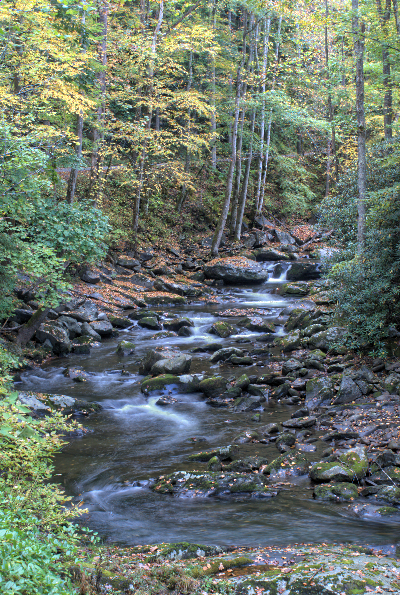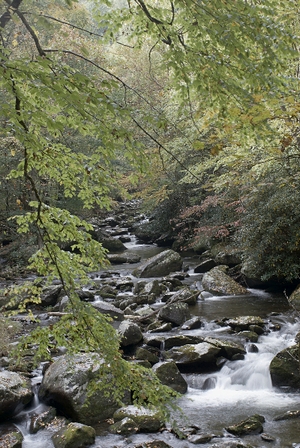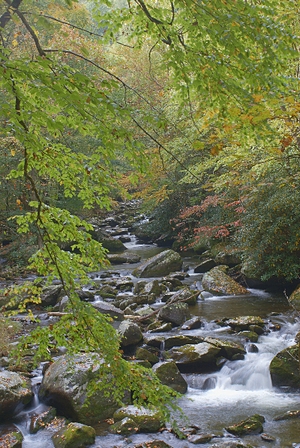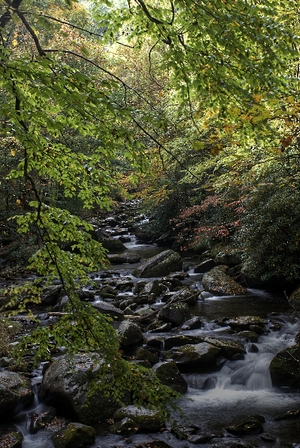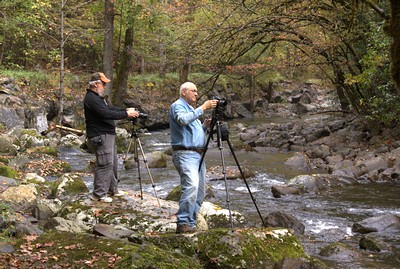It rained lightly all last night and into the first part of the morning. That may not bode well for many outdoor activities, and you might assume that it would be a bad thing for photography, what with everything being wet and the sky being overcast. Au contraire; while overcast skies reduce lights levels, we tend to work on tripods for landscape photography anyway, so that is not a problem. On the plus side, the lighting is much more uniform, which helps in situations such as narrow river valleys with lots of tree cover where strong direct sunlight causes unmanageably large dynamic ranges and can create troublesome specular highlights. On the downside, colors tend not to be as vibrant as one might like. On the upside, having everything freshly wet deepens the color and overall tone of the scene.
But first we went to breakfast and kept an eye on the weather, because none of us felt like actually working in the rain. The overcast hung around, with low clouds in the valley by our camp, but the rain stopped and we headed back into the Great Smoky Mountain National Park Cades Cove entrance. We immediately headed up the road that runs along the Middle Prong of the Little River. Lou had scouted this road previously and knew that it ran for about 6 miles, the first couple paved and the rest newly redone gravel. There were two narrow bridges before the turnaround at the end, and lots of places for one or two cars to pull off. We had a caravan of three vehicles, so finding good spots to stop was a little hard, but I think we found some good ones as I hope the photographs in this post demonstrate.
The Middle Prong drops gently but persistently for its entire length, and is littered with rocks and boulders the whole way, providing lots of possible “water shots.” There was one waterfall opportunity as well, but it did not have much water running over it today. We stopped anyway.
My main “focus” for today was learning how to use the High Dynamic Range technique. This is a two step process that is primarily suitable for photography stationary objects or scenes, such as landscapes. Step 1 involves shooting the scene with a range of exposure settings from under-exposed to over-exposed. Step 2 involves the use of post-processing software to combine the set of images into a single final image. I downloaded Luminance HDR (32 bit) the other night and installed it, but hadn’t had a chance to work with it yet.
I got a set of images to work with while Linda took some excellent photographs on her cell phone. She is much more inclined to capture images with her cell phone or her iPad than I am and we have spent a little time on cell phone camera/image apps in the workshop. We headed back around noon, had a bite of lunch, and headed back to the classroom around 1:30 PM for our final session. The topics today included HDR, cell phone apps, programs for making collages and videos from still photos, and Adobe Lightroom.
We originally planned to meet Friday morning to review images, but we wrapped up around 4 PM and decided that we had taught/learned as much as we could for the week. That will allow Linda and me to get an earlier start tomorrow than we originally expected. Back at the rig I hooked up the water softener and water line to the coach and refilled the fresh water tank. I then worked on editing images and composing this blog, with some time out for a simple but very tasty dinner of green salad with granola topping and whole wheat penne pasta with sun-dried tomatoes and homemade marinara sauce.
Lou was interested in seeing how WordPress works, so I agreed to meet him back at the classroom after dinner. I decided to show him how I create a blog entry in real time by building this one.
